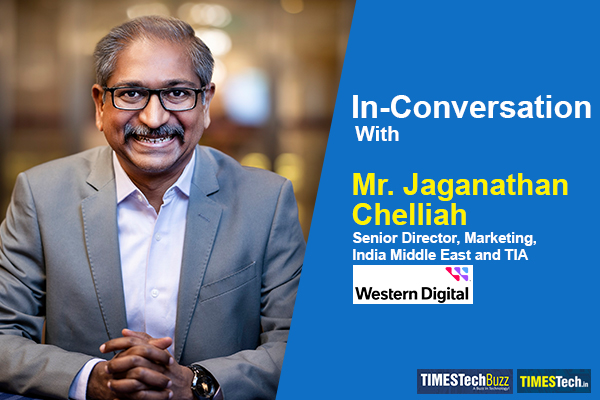The government of India started Smart Cities Mission in 2015 for urban renewal and retrofitting. The aim of the mission to develop smart cities across the country, making them citizen friendly and sustainable. The internet of things or IoT, a system of interrelated computing devices, enables transfer of data over a network. It doesnot requiring human-to-human or human-to-computer interaction. TimesTech in an interaction with Jaganathan Chelliah, Senior Director, Marketing, India Middle East and TIA, Western Digital tried to learn about IoT in Smart Cities, issues in its implementation, policy and support from the government and much more.
Read the full interview here:
TimesTech: Why is IoT integral to the idea of smart cities?
Jaganathan: Smart cities are built on technology and data. The objective of smart cities is to improve outcomes in every aspect of operations. Further, to offer residents a better quality of life. The key to a smart city is to unlock the potential of data and influence decision-making. A number of cities are still working to improve their infrastructure. However, smarter cities are embracing technologies like artificial intelligence, machine learning, the IoT, and big data. This is in order to boost sustainable development, meet residents’ expectations, and improve their resilience.
While different technologies have various applications, IoT is the one of the most critical of them. The use of IoT devices such as connected sensors, lights, and meters collect and analyze data. Reports estimate that by the year 2025, 55.7 billion connected devices will be generating almost 80 zettabytes (ZB) of data. Hence, smart cities will need a robust data architecture to properly capture, preserve, access, and transform this data in its journey – not just in cloud data centres, but at edge servers and endpoints. This data can then be used to optimize and improve the efficiency of various systems within a city, such as transportation, energy usage, and public services. Additionally, IoT enables real-time monitoring, control, and communication between different systems, resulting in a smarter and more connected city. Overall, IoT or Internet of Things plays an important role in smart cities. This is in terms of making their environments more efficient, sustainable, and liveable.
TimesTech: How can IoT help improve and build smart cities?
Jaganathan: IoT can help improve and build smart cities in several ways. IoT sensors and devices can be used to monitor and manage critical infrastructure and utilities. Such as water supply, energy distribution, and transportation systems, improving efficiency, and reducing costs. Intelligent Transportation systems, powered by smart cameras, computer vision, and robust storage solutions allow smart city movement. Another aspect of smart cities is that public safety. This is ensured by deploying smart videos backing them with artificial intelligence (AI) algorithms and deep learning (DL). Other applications of IoT include smart waste management, access to better healthcare and a more sustainable environment. However, no matter what the focus for smart cities is though, data is fundamental to achieving the desired outcomes.
As a result, storage is critical for smart cities, which is also evolving to keep pace with digital technologies and their use cases. Different types of storage are needed depending on the requirement. For example, to store big data so that it can be used to unveil meaningful insights, high-capacity and high-performance hard disk drives (HDDs) are ideal. Moreover, for applications that need low latency and high availability of data, performance NVMe SSDs are required.
Additionally, CCTV or video surveillance requires storage on the edge or on camera. India is working aggressively toward the smart city initiative to offer a better life to the residents. Smart cities are also being developed rapidly. This is to accommodate the expansion of urbanization and to face the challenges posed by it. Data and data-driven technologies are crucial for smart cities to become smarter and more sustainable. Therefore, the importance of storage technologies will continue to grow.
TimesTech: What are the core issues of IoT in Smart cities?
Jaganathan: IoT has immense potential to transform smart cities. However, there are a few challenges in the implementation of IoT solutions. For many IoT applications, it has become critical for data to be screened and analyzed. It is generated – from sensors in a car, surveillance cameras, drones, personal devices, robots, gateways, etc. – and even transformed there. The ability to deliver real-time analytics at the network’s edge can improve operational efficiencies, provide safer driving, create more secure environments, foresee upcoming maintenance, identify customer buying behaviors, and enable a world of opportunities.
Network latency is a challenge. It takes too long to store and forward data, whose value exists now. Edge storage manages data captures and provides the compute capabilities that aggregate and analyze that data in real-time, to deliver immediate and actionable insights at the device level.
Another challenge that one may encounter is the sheer volume created by sensors. This staggering amount of data impedes the ability to efficiently access, manipulate, and gain insights from the vast and diverse world of data collected.
Hence, to address the varied challenges, adaptive solutions are required by governments and enterprises alike to handle everything from small-footprint storage for the application stack of the smart sensor to an Edge gateway server, which is also resistant to high temperatures and humidity. Western Digital offers a variety of storage solutions built to fit the evolving needs of the IoT market.
TimesTech: Example of innovative use of IoT in smart cities in India/Globally?
Jaganathan: The Indian government has been bullish on the Smart Cities mission that was launched in 2015. Media reports suggest that by March 2023, 22 Indian cities will have fulfilled the Centre’s Smart Cities Mission. In the remaining 78 cities selected under the mission, the ongoing projects will be completed in the next three-four months. However, several cities have made advancements and have leveraged IoT for various solutions.
A few interesting use cases include Surat’s IoT-based smart water metering system that enables real-time monitoring of water usage, reduces water wastage, and improves billing accuracy. Another use case is of Pune smart city working to deploy all 24 smart city features in a “future ready” manner. The city has targeted 10% wastewater recycling in the ABB region, and zero waste and garbage ABB region through garbage truck augmentation, RFID tracking of vehicles, RFID-based attendance system, and monitoring of garbage areas.
Globally, countries have leveraged IoT to create next generation use cases. For instance Copenhagen is known for its leadership in clean technology, and commitment to being carbon neutral by 2025. Barcelona monitors rainfall using IoT sensors in the ground to optimize the city’s sprinkler systems, saving water. Singapore has worked to establish itself as one of the most sustainable countries in the world. The country deployed IoT solutions for smart traffic monitoring and efficient lighting.
TimesTech: How can government policies and support further increase the use of IoT in smart cities?
Jaganathan: The Indian Government aims to develop connected smart cities through IoT solutions to provide core infrastructure, a clean and sustainable environment, and a better quality of life to its citizens through initiatives such as Smart Cities Mission and Digital India. Aligned with this mission, the Indian Government recently announced a massive expansion of its Smart Cities Mission, targeting an ambitious goal of modernizing 4000 cities in the next two years. Focus areas include the Internet of Things, Integrated Command and Control Centres (ICCCs), mobile technologies like GPS, smart cameras for security and surveillance, smart meters, drones, and mobile applications for telemedicine and digital platforms.
The government is leveraging technologies such as Big Data; Internet of Things; Data Analytics; Artificial Intelligence; Digital Twinning; Cloud Computing; 5G; Virtual, Augmented and Mixed reality to enable the development of smart policies, smart governance, and smart citizenship. These technology platforms used by cities have to be designed in a way it enables efficiency for the government and allows public access to useful data. These platforms include cloud computing services, sensor networks, data centers, and traffic management systems for both road congestion management as well as public transportation systems such as subways and light rail. Policies built on top of these platforms include e-government portals and e-government services that allow citizens access to data on shared Application Programming Interfaces, leveraging the information for community benefits.















